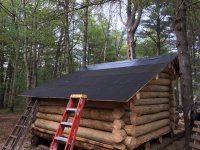Having been a contractor for 13 years or so I dealt with roofing matters all the time. Common perceptions about metal roofing seem to be that it is indestructible, permanent, hail-proof, and maintenance-free. None of those are accurate.
I always recommended metal roof owners have the roof inspected at least every second year, with particular attention to all penetrations (vents, chimneys, and fasteners). Here in southern Colorado (near-desert environment with 320-plus days of sunshine per year and wide swings in temperature) there are a number of issues that can become concerns:
1. Temperature changes (chilly nights, warm sunny days) cause all building materials to expand and contract frequently. Metal and wood expand and contract at different rates, transferring stresses that can cause fasteners to loosen, and creating gaps through which rain and snow melt can infiltrate.
2. Neoprene washers on mounting screws will deteriorate due to exposure to sunlight (ultraviolet) and heat, with resulting cracks and openings through which rain and snow melt can infiltrate.
3. Flashings at vents and penetrations can shift position, causing gaps through which rain and snow melt can infiltrate.
All of these issues can be dealt with by experienced installers, but such inspections and adjustments (screw/washer replacement, flashing adjustment and sealing, etc) require time and materials/supplies. In addition to about $20 per hour wage for an experienced hand the contractor will be paying FICA (employer contributions totaling 7.65%), unemployment insurance (typically about 4%), and workers compensation insurance (for roofers this runs about 35-40%). So a $20 per hour employee costs +/- about $28 to $30 per hour. Travel time to and from, vehicle expense, and other normal business costs add more. And we still haven't thought about contractor profit, licensing, liability insurance, office & staff expenses, etc. Working on a pitched metal roof is dangerous, always requiring body harnesses, safety lines, etc, with one worker attending to safety while another worker attends to the business at hand.
Invariably, when a customer owning a 3000 sq. ft. metal roof learned that it would take a two-man crew about a day-and-a-half to perform a proper inspection and tune-up (roughly 24 man-hours, plus supplies/materials, associated expenses, adding up to a raw cost of $1000 or so) and the contractor quotes $1250 to $1500 for the job, Mr. and Mrs. Customer decide to pass, since there is no immediate problem to justify spending a chunk of money.
When (not "if", but "when") leaks start, damage to drywall, insulation, carpets, home contents, the homeowner calls their insurance company. Mr. Inspector/Adjustor comes out, evaluates the problem as resulting from maintenance issues that could have been prevented by routine maintenance, then the yelling starts!
Homeowners insurance policies are not home maintenance contracts. Insurance only covers damage caused by specific types of incidents (such as fire, windstorm, hail, vandalism, theft, etc), it does not cover routine maintenance. Even when coverage is provided for interior damages there remains the policy deductible (not unusual for deductibles to be 2% or more of the value of the home, so a $150,000 house may have a deductible of $3000 or more). There may also be specified policy limits for certain types of property (cash, firearms, precious metals, antiques, collectibles, pairs-and-sets limitations, and others).
Of course, such claims stack up quickly after major storm activity. Your call to the insurance company may result in an adjustor showing up in a week or two. Then your calls to contractors might result in another week or two waiting for repair estimates. Finally, when you select a contractor it might be a couple of months before there is an opening to schedule the work (assuming repair materials are available; not always the case after heavy storms). During that interim there may be additional damages beyond what the adjustor found and settled the claim on; then you may find that such additional damages are not covered because they could have been prevented by immediate repairs!
Occasionally, the next step in the process is hiring a lawyer to sue the contractor who installed the roof and (of course) never bothered to explain to Mr. & Mrs. Homeowner that the shiny new metal roof was neither indestructible, permanent, hail-proof, or maintenance-free. Ever wonder why a contractor's warranty is multiple pages of legalese devoted to every conceivable limitation in application?
Feel free to guess why I no longer build houses and run a roofing company! Leather shops are comparatively peaceful and lawyer-free.


